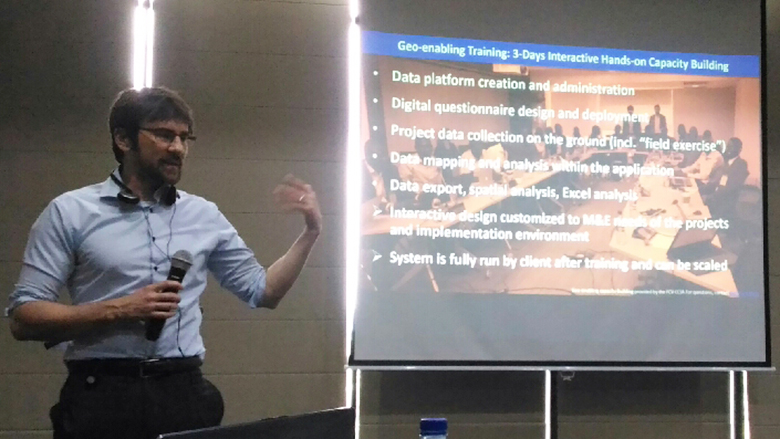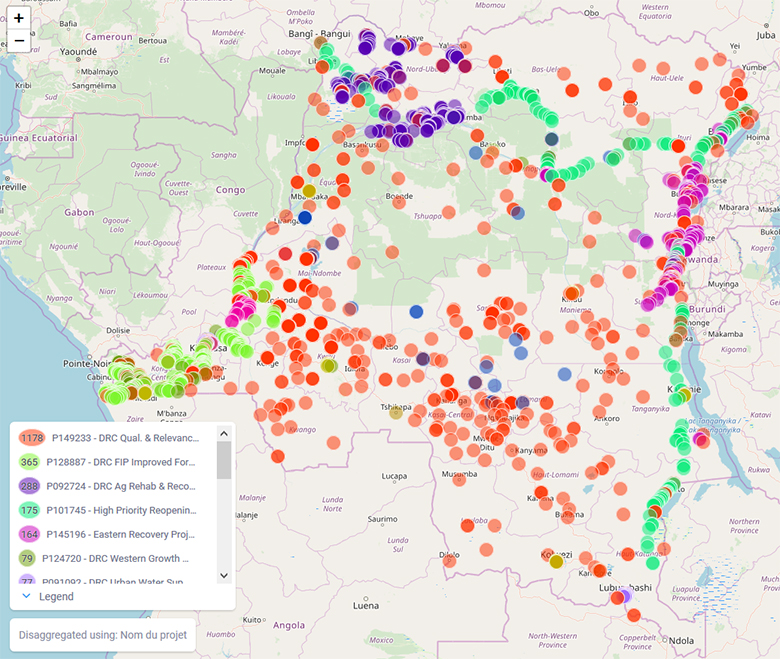Bernhard Metz, a Social Development Specialist at the World Bank, is the Lead of the Geo-Enabling initiative for Monitoring and Supervision (GEMS) managed by the Fragility, Conflict & Violence Global Theme. Bernhard answered a few questions to explain the use, potential and results of the initiative.
What is the Geo-Enabling Initiative for Monitoring and Supervision (GEMS)?
GEMS is a method that enables project teams to use simple open-source tools to collect structured digital data right from the field. This data automatically feeds into a centralized Monitoring & Evaluation (M&E) system.
While it is an ICT-based system, our focus does not lie on fancy tools and gimmicks, but on building capacity among clients to use simple solutions for their specific needs.
How does GEMS help address M&E challenges?
One of the ideas of GEMS is to "bring eyes on the ground where we cannot always have feet on the ground." We try to create systematic ways of getting insights into geographic areas where access for development practitioners is either nonexistent or limited due to active conflict, high insecurity, or logistical constraints.
This is especially relevant to situations of fragility conflict and violence (FCV). Simplicity is key in these settings—so everything we do builds on straightforward, easy-to-learn methods and free, open-source tools targeted toward local stakeholders working in the field–whether they are staff from our government clients, partners, or World Bank colleagues.
The system used by GEMS is based on KoBo Toolbox, a free set of tools provided by the Harvard Humanitarian Initiative. What is the value added by the World Bank?
The core of GEMS is to systematically build the capacity of teams working on project monitoring and evaluation, supervision, safeguards, procurement, and impact evaluation. The training aims to teach teams everything they need to run their own customized digital monitoring platforms, based on their specific needs, and to scale its use independently. You can learn everything you need to use GEMS and train others in just a few days, even if you do not have any background in information technology or geographic information systems.

Since the tools are easy to use, our training doesn’t need to focus on the technology, but on skills: we try to create a Global Public Good by showing local stakeholders simple ways to improve the effectiveness of their work. In this regard, we are focusing on better real-time field insights, better decision-making, and better development outcomes.
What results has the initiative achieved so far?
As of November 2019, we have trained about 2,000 clients, partners and field staff covering close to 400 World Bank-funded projects in 30 countries. Through this, data of more than 100,000 sub-projects and activities have been mapped. GEMS has been used extensively in the field including for remote supervision and enhanced M&E of project implementation, risk and safeguards monitoring, beneficiary engagement, and security assessments in Azerbaijan, Burkina Faso, Burundi, Cameroon, CAR, Djibouti, DRC, Guinea, Haiti, India, Indonesia, Kenya, Madagascar, Mali, Mauritania, Myanmar, Niger, Nigeria, Pakistan, Republic of the Congo, Senegal, Somalia South Sudan, Uganda and several Pacific Island States.
What have you learned from the rollout of GEMS?
South Sudan was our pilot country and it proved very challenging. The entire territory, except for the capital Juba, is off-limits for Bank staff, and project implementation teams also face difficulties accessing certain parts of the country. As you could imagine, the clients were eager to use GEMS to get better insights on the dynamics on the ground, and in real time. For instance, a health project team used the system to map existing facilities and track the availability of health services in remote areas.
We have also seen how GEMS has been used in a variety of contexts and project stages beyond M&E. In Niger, GEMS informed a baseline study on host communities to plan a displacement project; in Myanmar and the Democratic Republic of the Congo, it helped monitor safeguards compliance; in the Sahel, it facilitates cross-agency coordination; and in Azerbaijan it serves as a communications and citizen engagement tool that is open for everyone to access through an interactive project map.
These are just a few examples of how, with solid training, the teams have gained the ability to independently customize the tools to serve their own specific needs.
What does a project implementation team need to get started with GEMS?
The GEMS method is not based on “rocket science”, but on “pocket science.” All you need to use it effectively in the field fits in your pocket –namely, a smartphone or a tablet. You also don’t need an internet connection in the field, because the system works offline and the gathered data stays on your device until you get back to a place that’s connected and you can then upload the information to the server.
Other than that, you only need to set aside three days for the training and, once finished, the teams fully own and run the system.
What is next for GEMS?
Going forward, GEMS will deepen its engagement in sub-Saharan Africa, while expanding its support in other regions, notably East Asia and Pacific, South Asia, Central Asia, and Middle East and North Africa. A particular focus will be to support the implementation on the IDA-19 Policy Commitment to build client capacity in the use of field-appropriate ICT in fragile and conflict-affected contexts. This goes hand in hand with the aim to create a Global Public Good for digital data collection and analysis in fragile settings.


